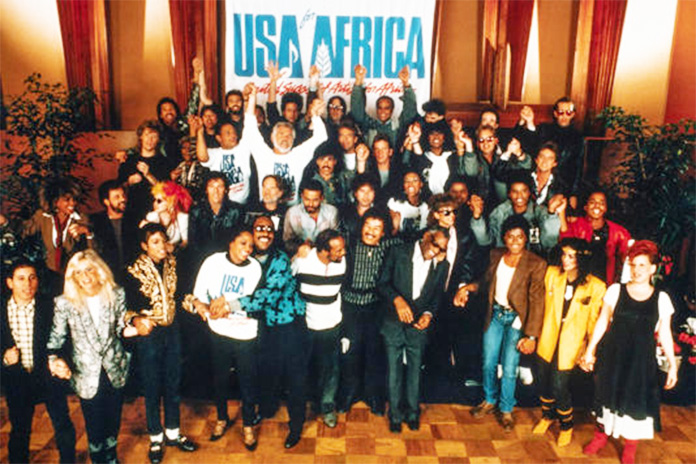
AT a time when there was a growing consciousness of the impact of globalisation and its importance in conveying messages, it was the entertainment industry that made good use of that movement to raise awareness of the plight of the less fortunate.
New wave rocker Bob Geldof of The Boomtown Rats started things off with his Band Aid project, which rallied English and Irish musicians to raise funds. Famine victims in Ethiopia were the beneficiaries of the proceeds of the charity single Do They Know It’s Christmas? (written by Geldof and and Midge Ure of Ultravox), released in December 1984.
Swift on the heels of this effort, the American music industry jumped onto the bandwagon. The idea, mooted by Harry Belafonte and music manager, producer and fundraiser, Ken Kragen, whose client list included Lionel Richie. This trio formed the catalyst for the project that assembled hot stars of that time Michael Jackson and Quincy Jones as part of the steering group.
Richie and Jackson were tasked with writing the song, together with Stevie Wonder (who didn’t answer phone calls and was left out of that process).
The song, We Are The World, was put together in a week, even as momentum gathered to bring in the 40 musicians of note to perform immediately after the American Music Awards (AMA) — which Richie was hosting — on 28 January 1985.
A multi-location concert on 13 July 1985 — Wembley Stadium in London and John F. Kennedy Stadium in Philadelphia — helped cement the concept of simultaneous live telecasts of concerts across countries (there were similar concerts held in many other countries at the same time). It was watched by 1.9 billion people in 150 countries, which was then around 40% of the global population.
ALSO READ: Importance Of Luck And Hardwork In Business
One Night Only
Although it’s been 38 years since those memorable recordings that sold millions, won awards, and, importantly, raised awareness of the plight of those suffering from famine, Netflix has just released The Greatest Night In Pop an insightful and warm documentary on the making of We Are The World.
The real stories behind an event are fascinating, for they provide additional dimensions to an established narrative.
How does one begin to bring together 40 musicians is quite an amazing feat.
Here’s a sampling of who showed up for the USA For Africa effort. Dionne Warwick, Bob Dylan, Bruce Springsteen, Kenny Rogers, Smokey Robinson, Cyndi Lauper, Willie Nelson, Paul Simon, Kenny Logins, Daryl Hall & John Oates….
Many were already at the AMA, so they extended their stay to head to A&M Recording Studios to lay down the track. Springsteen had just finished a long tour the night before but flew in to join the session.
Prince had been asked, but not being one for large crowds, never took up the offer.
But the combined star power of Richie, Jackson and Jones was enough to bring in other musicians.
While parts of the recording have been aired during the official video, it’s the goings-on behind the scenes and leading up to the actual recording that are presented in an engaging and entertaining way by director Bao Nguyen.
In the first place, the fact that these top-earning musicians and everyone else involved in this recording did it for free sends a strong signal about the potential of the creative arts to effect change.
All Equals
At the entrance to the studio, Jones pasted a sign — Check Your Ego At The Door.
Geldof’s short speech about why they were doing this put everything in perspective and brought the excitement levels of superstars meeting superstars to a more down-to-earth level.
Without minders and their usual hangers-on the stars were stripped down to their true selves, which showed up more the longer the night wore on. Lauper was still feisty, Diana Ross was drinking in the occasion, Dylan was trying very hard to fit in.
Richie was the livewire, keeping the energy flowing while Jones was the teacher who had to turn on the right kind of charm to get the recording session done by the morning.
Scenes from the original recording session are given context by updated interviews with Richie, Lewis, Springsteen, Lauper and other stars who reflect on the session with great fondness. It’s eye-opening to hear their take on that magical night when they stood shoulder-to-shoulder, literally, with their peers.
While the songs of that era of fund raising were generally more like long jingles and represented the givers’ perspective, they still achieved the purpose of raising money.
Has It Helped?
To some extent.
Today, with a global population pushing past 8 billion, the troubles are still there.
Ethiopia’s food crisis has deepened with wars and the worst drought in decades, with over 20 million people in need of assistance.
Climate change could result in more famines. Wars will continue to destroy lives and societies around the globe. Economic divides and selfish motivations will ensure there will always be the haves and have nots.
In today’s media environment, it would be hard to imagine artists banding together to champion a cause. They’d be too busy pushing their own agendas on their social media platforms, getting as many views and impressions to satisfy their desire for fame on the small personal screen.
While the We Are The World generation of stars was pushing hard to get out there, today’s generation seems to be busy trying to draw them into their own private viewing space on digital screens.
It’s not so much give because We Are The World as it is I Am Your World, so like me.
The Greatest Night In Pop is showing on Netflix.





















